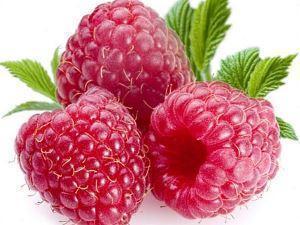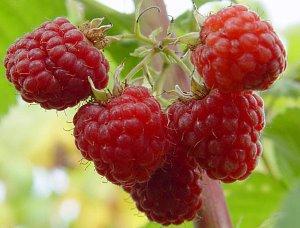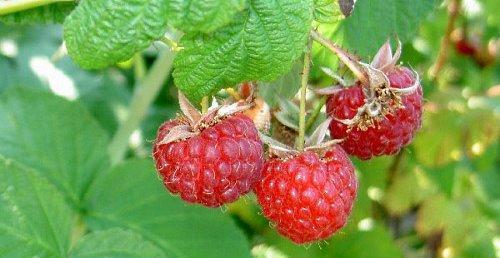Common raspberry - reproduction and care
 Common raspberry is a thorny dwarf shrub characterized by branching. It has a perennial rhizome and is characterized by erect shoots that can reach two meters in height.
Common raspberry is a thorny dwarf shrub characterized by branching. It has a perennial rhizome and is characterized by erect shoots that can reach two meters in height.
In the first year, the shoots are fluffy and only their lower part is covered with small and thin brown thorns. In the second year, they become strong and begin to bear fruit, after which they dry up, and new shoots grow from the rhizome and the two-year life cycle begins anew.
The plant itself not only bears tasty fruits, but also has an attractive appearance, so the photo of common raspberry is popular. On the relatively long petioles of the shrub, there are odd-pinnate, compound and alternate leaves, with an average of five to seven leaves, the upper of which are trifoliate and have stipules. The white flowers of the common raspberry are small and have five petals.

The culture blooms in June-July, and the fruits begin to ripen around July-August. Common raspberries bear fruit unstably over the years. The weather affects the yield: cold and rainy weather prevents the necessary pollination by insects. Reproduction of common raspberries occurs vegetatively or by seeds.
Read the article about crimson tree!
The main varieties of common raspberries
There are four main groups of common raspberry varieties according to the ripening period:
- early;
- medium;
- late;
- repairing.

Among the varieties of common raspberries of early ripening, one can distinguish:
- Scarlet sail. The variety is winter-hardy and resistant to various diseases. The yield reaches 1.7 kg of fruits from one bush.
- Runaway. This variety is popular among amateur gardeners, its yield can reach 2 kg of berries per bush.
- Abundant. A large crop shrub produces dense, bright red berries.
- Early sweet. The variety is characterized by an average yield and high winter hardiness.
- An early surprise. A medium-sized bush can produce up to 1.5 kg of berries.
- Sun. Raspberry berries are large, the bush is moderately resistant to disease and frost.
- Meteor. A powerful bush culture is resistant to major diseases.
- Cumberland. The variety is distinguished by fruits of black-purple color.
Some varieties of common raspberries of average ripening:
- Balm. A medium-sized bush brings good yields and is resistant to major diseases and spider mites.
- Arabesque. Unpretentious variety.
- Crane. A small bush can produce about 2 kg of ruby fruits per year.
- Kirzhach. The variety is in demand among amateur gardeners due to its high yield.
- Reward. A medium-sized plant produces up to 2 kg of red berries annually.
- Modest. The common raspberry variety is characterized by a stable and high yield.
- Tarusa. The bush does not require support and produces large, dense and transportable berries.
Late ripening varieties:
- Latham. Variety from America.
- Brigantine. The bush of the plant is sensitive to mites, but has a high yield.
Repairing varieties of common raspberries:
- Indian summer. The first berries of the plant ripen before the onset of frost.
- Yellow giant.Large-fruited and low-maintenance variety.
Growing and caring for common raspberries
Experts advise planting the plant in spring or autumn. If the planting of a bush takes place in the autumn, then it should be hilled for the winter, and with the onset of spring, it should be uncooked.
A plant in one place can grow up to 20 years, but the productive period is considered to be up to 12 years old. The yield depends on the characteristics of the variety and the degree of care for common raspberries.
The plant does not tolerate drought, but at the same time, stagnation of water should not be allowed. Bushes develop well and bear fruit on loose soils.
 Culture needs support, so experts advise using trellises. When fastened, the branches of the plant are distributed evenly in different directions and tied to the support.
Culture needs support, so experts advise using trellises. When fastened, the branches of the plant are distributed evenly in different directions and tied to the support.
In autumn or after harvesting, the stems should be removed. In the spring, the frozen top is cut off to a healthy part. Raspberry pruning ordinary occurs in the spring, while the shoot of the plant is shortened to the first developed bud.
Pruning the top by about 10-14 cm perfectly stimulates the formation of new fruit branches. Shoots that appeared in the second half of summer and are of no value are recommended to be destroyed.
Caring for common raspberries is also thinning, which should be carried out in early spring. For a meter of area where the culture grows, it is necessary to leave about 10-15 healthy and strong bushes. To stimulate the growth of a young shoot in mid-August, it is recommended to pinch the top.

The culture should be processed potash and nitrogen fertilizers... Caring for common raspberries also includes shallow loosening of the soil near the bushes and weeding.
Reproduction of common raspberries:
- Root offspring. From the second half of summer, it is necessary to break in the offspring of raspberries and separate them from the main rhizome with a lump of earth. Then they should be transplanted to a permanent place. It is advisable to carry out the process in cloudy weather. It is recommended to fill the hole where the offspring will be planted with a liter of water.
- Root cuttings. They must be harvested when digging root suckers or removing them. Cuttings are sorted, then collected in bundles and placed in small boxes, where the interlayer is peat and sand. Then they are placed in a cool room, where they are stored until spring. Common raspberries, which reproduce in this way, are planted in early spring. The soil is preliminarily loosened and leveled. Small grooves are made at a distance of about 70 cm from each other, into which the cuttings are placed. The ground is then well watered and covered with a protective film.
- Seeds. The method is suitable only for breeders.
Useful properties of common raspberries
 Fresh fruits of the culture have not only a pleasant aroma and excellent taste, but also have a number of useful properties:
Fresh fruits of the culture have not only a pleasant aroma and excellent taste, but also have a number of useful properties:
- antipyretic;
- anti-inflammatory;
- diaphoretic;
- pain reliever.
The berries of the culture contain many beneficial trace elements, including copper and molybdenum. Fruits perfectly quench thirst, improve digestion and accelerate the removal of harmful substances. The beneficial properties of common raspberries are actively used in the prevention and treatment of anemia, atherosclerosis, diabetes mellitus and hypertension.